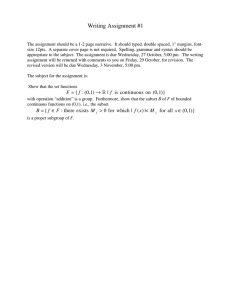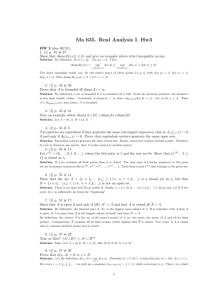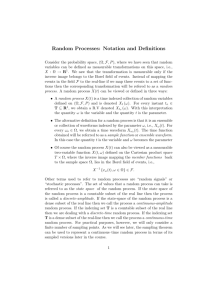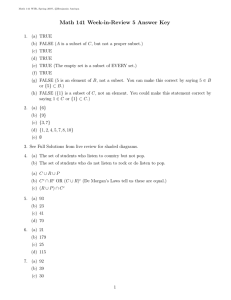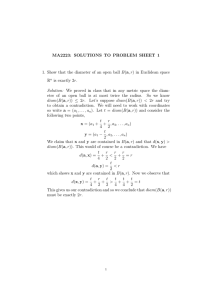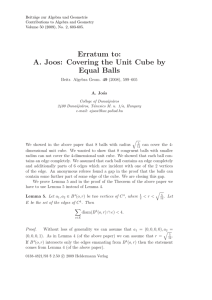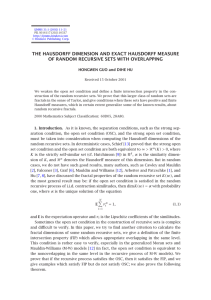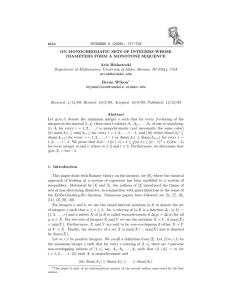Solution Set #1 Section 6.1 1. Example 1.
advertisement
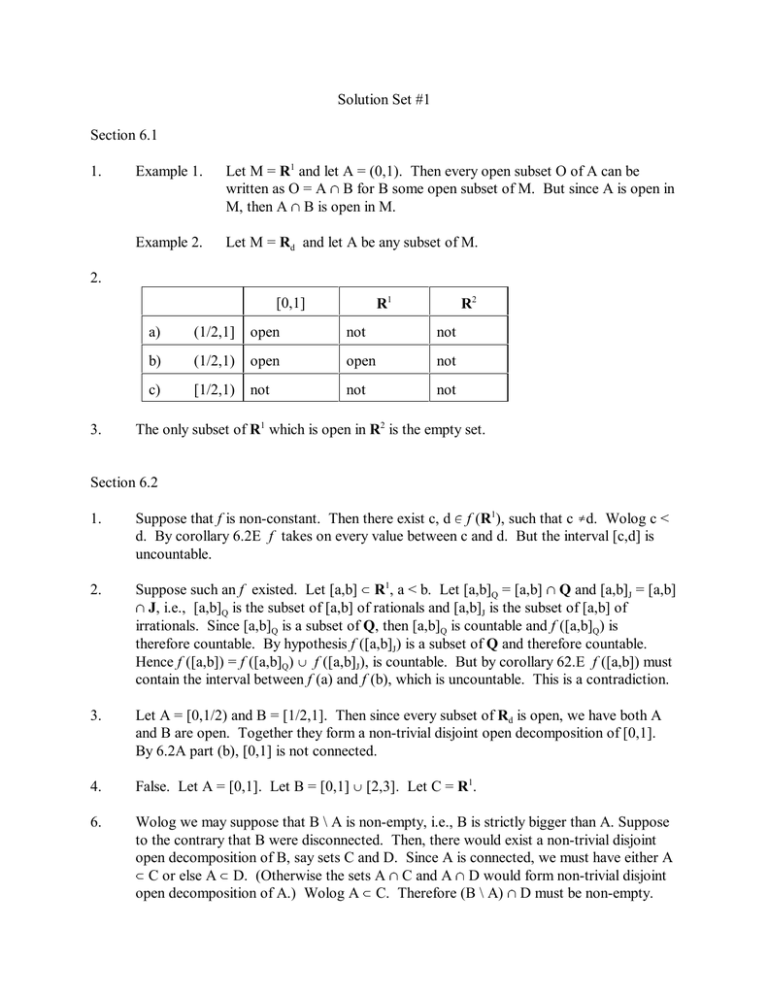
Solution Set #1
Section 6.1
1.
Example 1.
Let M = R1 and let A = (0,1). Then every open subset O of A can be
written as O = A 1 B for B some open subset of M. But since A is open in
M, then A 1 B is open in M.
Example 2.
Let M = Rd and let A be any subset of M.
2.
R1
[0,1]
3.
R2
a)
(1/2,1]
open
not
not
b)
(1/2,1)
open
open
not
c)
[1/2,1)
not
not
not
The only subset of R1 which is open in R2 is the empty set.
Section 6.2
1.
Suppose that f is non-constant. Then there exist c, d 0 f (R1), such that c úd. Wolog c <
d. By corollary 6.2E f takes on every value between c and d. But the interval [c,d] is
uncountable.
2.
Suppose such an f existed. Let [a,b] d R1, a < b. Let [a,b]Q = [a,b] 1 Q and [a,b]J = [a,b]
1 J, i.e., [a,b]Q is the subset of [a,b] of rationals and [a,b]J is the subset of [a,b] of
irrationals. Since [a,b]Q is a subset of Q, then [a,b]Q is countable and f ([a,b]Q) is
therefore countable. By hypothesis f ([a,b]J) is a subset of Q and therefore countable.
Hence f ([a,b]) = f ([a,b]Q) c f ([a,b]J), is countable. But by corollary 62.E f ([a,b]) must
contain the interval between f (a) and f (b), which is uncountable. This is a contradiction.
3.
Let A = [0,1/2) and B = [1/2,1]. Then since every subset of Rd is open, we have both A
and B are open. Together they form a non-trivial disjoint open decomposition of [0,1].
By 6.2A part (b), [0,1] is not connected.
4.
False. Let A = [0,1]. Let B = [0,1] c [2,3]. Let C = R1.
6.
Wolog we may suppose that B \ A is non-empty, i.e., B is strictly bigger than A. Suppose
to the contrary that B were disconnected. Then, there would exist a non-trivial disjoint
open decomposition of B, say sets C and D. Since A is connected, we must have either A
d C or else A d D. (Otherwise the sets A 1 C and A 1 D would form non-trivial disjoint
open decomposition of A.) Wolog A d C. Therefore (B \ A) 1 D must be non-empty.
But if x 0 B \ A, then x must be a limit point of A. But, as a consequence of theorem
5.5D if x is a limit point of A and if x lies in an open set D, then D 1 A ú i. This
contradicts the fact that A d C and C 1 D = i.
Section 6.3
1.
Suppose that B is a bounded subset of R2. Then there exists L such that B is contained
inside the square S with corners (diametrically opposite) <-L,-L> and <L,L>. Let g > 0.
Let h
'
g
. Cover S with a rectangular grid of (closed) cells whose parallel sides are
2
| h |
<L,L>
<-L,-L>
distance h apart. Let N
' [[ 2 L ]]%1 . Then, there are at most N2 cells in the grid, each
h
cell has diameter g, and the collection of cells in the grid covers S which contains B.
3.
Example 1.
S = {sn} where each sn = <1/n, 0 , 0 , 0, 0, . . .>, for n = 1, 2, 3, . . . Then,
each sn 0 2 and || sn - sm ||2 = |1/n - 1/m|. It is easily seen that each
subsequence of S is Cauchy.
Example 2.
S = {sn} where each sn = <0, 0, 0, . . ., 1/n, 0 , 0 , 0, 0, . . .>, where the
single non-zero entry is in the nth slot, for n = 1, 2, 3, . . . Then, each sn 0
2
and || sn - sm ||2 = (1/n2 - 1/m2 )1/2. It is easily seen that each subsequence
of S is Cauchy.
4.
Let S = {x1, x2, . . . , xn} be a finite subset of M. Let g > 0. Choose sets Ak = B(xk, g/2)
for k = 1 .. n. Then, the sets {A1, A2, . . . , An} cover S and each Ak has diameter g.
5.
Let g > 0. Since M is total bounded there exist sets {A1, A2, . . . , An} in M such that
n
diam(Ak) < g and M d ^ Ak . But since A d M, we also have for Bk = Ak 1 A that
k'1
n
diam(Bk) < g and A d ^ Bk .
k'1
7.
Denote A = A0. We will show that there exists a sequence in A0 which is Cauchy. Since
A0 is bounded there exists a closed bounded interval J0 such that A0 d J0 . Let diam(J0 ) =
d.
Find the midpoint of J0 and divide J0 into two subintervals of equal width. Since A0 is
infinite, at least one of the these subintervals must contain an infinite number of points.
Choose one of them and call it J1. Note that diam(J1) = d/2. Let A1 = J1 1 A0.
Find the midpoint of J1 and divide J1 into two subintervals of equal width. Since A1 is
infinite, at least one of the these subintervals must contain an infinite number of points.
Choose one of them and call it J2. Note that diam(J2) = d/4. Let A2 = J2 1 A1.
Proceed inductively to find for each k = 1, 2, 3, ... sets Jk such that each Jk d Jk-1 and
diam(Jk) = d/2k and Ak = Jk 1 Ak-1 where each Ak is infinite. The sets {Jk } satisfy the
4
nested interval theorem and hence the property _ Jk is a singleton.
k'1
4
4
k'1
k'1
Since each Jk 1 A0 úi and diam(Jk) = d/2k and _ Jk 0 Jk, then we see that _ Jk is a cluster
point of A0.

